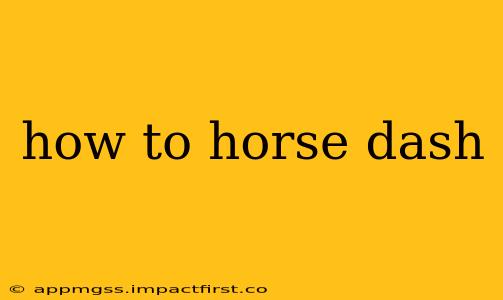How to Horse Dash: A Comprehensive Guide to this Thrilling Equestrian Sport
Horse dashing, also known as horse racing or simply dashing, is a thrilling equestrian sport that tests the speed, stamina, and skill of both horse and rider. While the specifics can vary depending on location and tradition, the core concept remains the same: a fast-paced race against other competitors. This guide will delve into the intricacies of horse dashing, covering everything from essential equipment and training to safety precautions and competitive strategies.
What Equipment Do I Need for Horse Dashing?
The equipment for horse dashing is crucial for both the rider's safety and the horse's performance. Essential items include:
- A suitable horse: The ideal horse for dashing possesses speed, stamina, and a calm temperament under pressure. Thoroughbreds and Quarter Horses are often favored for their athleticism. Breed isn't everything though; training and conditioning play a huge role.
- A well-fitting saddle: The saddle should be comfortable for the rider and secure on the horse, preventing slippage during the race. The type of saddle will often depend on the style of dashing.
- Bridle and bit: A comfortable and properly fitted bridle and bit are crucial for controlling the horse during the race. The type of bit may vary based on the horse's personality and the rider's preferences.
- Protective gear for the rider: This includes a helmet (mandatory!), protective vest, riding boots with heels, and possibly gloves. Safety is paramount.
- Protective gear for the horse: While not always standard, some dashers choose to use boots or bandages to protect the horse's legs from injury.
What is the Best Training for a Horse for Dashing?
Training a horse for dashing requires patience, consistency, and a gradual approach. It's crucial to prioritize the horse's well-being and avoid pushing it too hard too soon. Training typically involves:
- Building stamina: This involves progressively increasing the duration and intensity of workouts, focusing on long, slow distance runs interspersed with periods of high-intensity sprints.
- Developing speed: Speed drills, such as short sprints and interval training, are vital for improving the horse's acceleration and top speed.
- Improving agility and responsiveness: Agility exercises, such as weaving through cones or navigating obstacles, can enhance the horse's maneuverability and responsiveness to the rider's commands.
- Working on obedience and control: The horse must be well-trained and responsive to the rider's cues, especially during the fast-paced and potentially chaotic environment of a race. This often involves lots of ground work and groundwork exercises to build trust and communication.
What are the Safety Precautions for Horse Dashing?
Safety is paramount in horse dashing. Both the rider and the horse must be well-protected, and all participants must adhere to strict safety guidelines. Important safety measures include:
- Using appropriate safety gear: Wearing a helmet and other protective gear is essential to minimize the risk of injury.
- Ensuring the horse's fitness: A horse that's not properly trained or fit is at a greater risk of injury.
- Following race rules and regulations: Adhering to race rules and regulations is critical for maintaining safety and fairness.
- Having a veterinarian on-site: In many organized events, a veterinarian is present to attend to any injuries.
- Proper track maintenance: The track itself should be well-maintained to minimize the risk of accidents.
What are the Different Types of Horse Dashing Competitions?
The specific rules and regulations of horse dashing competitions can vary considerably depending on the location and tradition. However, common elements include:
- Distance: Races can range from short sprints to longer endurance events.
- Number of participants: Competitions can feature a small number of competitors or a large field of horses.
- Track type: Races can take place on various surfaces, including dirt, turf, or sand.
- Obstacles (sometimes): Some competitions may incorporate obstacles that add to the challenge.
Are there any age or weight restrictions for horse dashing?
Age and weight restrictions vary considerably depending on the specific competition and governing body. Some competitions may have minimum age requirements for both horse and rider, while others may have weight limitations to ensure fairness and safety. It is essential to check the specific rules and regulations of each competition before participating.
This comprehensive guide provides a solid foundation for understanding horse dashing. Remember, always prioritize safety and responsible horse management in this exciting and challenging equestrian pursuit. Further research into local racing organizations is recommended for those looking to participate in a competition.
